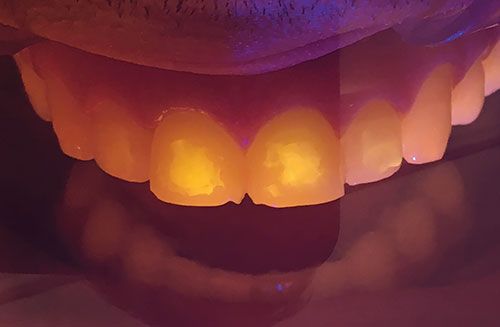Drs. Roberto Soares da Silva Júnior, Lídia Parsekian Martins, Larry W. White, and Renato Parsekian Martins offer advice for removing residual adhesives on debonding day
Failure to completely remove adhesive remnants after bracket debonding can lead to pigmentation due to aging1,2 and produce retentive areas that can favor the accumulation of dental plaque and caries.2 This procedure is one of the hardest jobs in orthodontics because commonly used orthodontic adhesives mimic sound enamel pretty well, making it difficult to clearly tell them apart. The inability of clearly seeing the adhesive can prevent the orthodontist from completely removing the adhesive without damaging enamel.
Methods to see adhesive remnants3-6 could assist the orthodontist in the removal process and diminish the probability of damage to the enamel. The addition of fluorescent chemicals to adhesives, such as done in Opal Bond* and Opal Seal*, is an evincing method that improves residual adhesive removal significantly without causing additional damage to the enamel.6
Fluorescence is the ability to emit light when exposed to ultraviolet (UV) radiation — i.e., the material absorbs the radiation at a shorter wavelength, invisible to the naked eye, and reflects visible light with a longer wavelength. UV fluorescent material can be detected by the naked eye by UV light, through a UV light lantern (Figure 1) or by a special lens that can be attached to the Valo Led**, with the downside that both methods require the purchase of products not normally used by orthodontists. However, the orthodontist can detect these types of adhesives in an easy and quick manner with devices that already exist in the office.

Figure 1: UV fluorescent material can be detected by the naked eye by UV light, through a UV light lantern
Figure 2: When these UV fluorescent adhesives are placed under any blue color curing light, they can be clearly viewed under an orange light shield or with the use of orange curing light protective glasses
When these UV fluorescent adhesives are placed under any blue color curing light, they can be clearly viewed under an orange light shield or with the use of orange curing light protective glasses (Figure 2). This can be very helpful when removing the residual adhesives without adding extra costs to the orthodontic office.
- Eliades T, Gioka C, Heim M, Eliades G, Makou M. Color Stability of Orthodontic Adhesive Resins. Angle Orthod. 2004;74(3):391-393.
- Karamouzos A, Athanasiou AE, Papadopoulos MA, Kolokithas G. Tooth-color assessment after orthodontic treatment: A prospective clinical trial. Am J Orthod Dentofacial Orthop. 2010;138(5):537.e 1-8 discussion 537-539.
- Pretty IA, Hall AF, Smith PW, Edgar WM, Higham SM. The intra- and inter-examiner reliability of quantitative light-induced fluorescence (QLF) analyses. Br Dent J. 2002;193(2):105-109.
- Rachala MR, Kishore MS, Vamisilatha K. Staining adhesive remnants for easy removal. J Clin Orthod. 2013;47(11):672.
- Abdallah MN, Light N, Amin WM, Retrouvey JM, Cerruti M, Tamimi F. Development of a composite resin disclosing agent based on the understanding of tooth staining mechanisms. J Dent. 2014;42(6):697-708.
- Ribeiro AA, Almeida LF, Martins LP, Martins RP. Assessing adhesive remnant removal and enamel damage with the aid of ultraviolet light: an in vitro study. Am J Orthod Dentofacial Orthop. 2017;151(2):292-296.
*Opal Orthodontics, South Jordan, Utah
**Ultradent, South Jordan, Utah
Stay Relevant With Orthodontic Practice US
Join our email list for CE courses and webinars, articles and mores


